Today’s recipe is bibimbap, a super-popular Korean dish you might have heard about already! It’s made of a bowl of rice, sautéed and seasoned vegetables (namul: 나물), a bit of hot pepper paste (gochujang: 고추장), and usually a bit of seasoned raw beef, too (yukhoe: 육회).
Bibim (비빔) translates as “mixed,” and bap (밥) means “cooked rice,” so bibimbap literally means “mixed rice.” Before eating it you’re supposed to mix everything all together.
There are many variations on this dish, from simple to elaborate, and this recipe I’m showing you today is for one you could consider “classic” bibimbap. If you ordered bibimbap in a Korean restaurant, you would probably get something like this dish, with regional variations. I’m also going to show you bibimbap prepared and served in a heated stone or earthenware bowl called dolsot-bibimbap (돌솥비빔밥). “Dolsot” means “stone pot” in Korean, and this version is well-known for the way the bowl makes a layer of crispy, crackling rice on the bottom of the bibimbap.
Even though we mix up bibimbap before we eat it, each ingredient needs to be prepared with care and individuality, bringing out their unique flavors, textures and colors so they come together beautifully in the bowl and deliciously in your mouth. The different ingredients aren’t random, they’re chosen because they balance, harmonize, and offset each other.
This recipe isn’t quick and easy, it takes some time to make. But if you’re really in a rush you can make a great bibimbap with the soybean sprouts, spinach, and carrot (or red bell pepper, or both), and gochujang, toasted sesame oil, and an egg— those items are unskippable!
I’m going to share some more bibimbap recipes on my website in the future, and you’ll see how many different variations there are. This version is a little different than the version in my cookbook, because I make a quick and simple soup with the bean sprouts. When I started my YouTube channel, bibimbap was one of the first recipes I made, because it’s such an essential dish in Korean cuisine. So I’m happy to remake the video now in HD with much better editing and instruction. I’ve been building up to this video by remaking videos for the ingredients, too. I remade yukhoe, and sigeumchi-namul, and my yukagaejang video has a lot of detail about preparing the mountain vegetable fernbrake.
So if you’ve been following my videos, you’re now ready to be a bibimbap master! Ready? Let’s start!
Ingredients
Serves 4
- 5 cups cooked short-grain rice
- 12 ounces soy bean sprouts, washed and drained
- 8 ounces of spinach blanched and washed with the excess water squeezed out by hand
- 1 large carrot
- 1 large red bell pepper
- 1 large zucchini
- 1 English cucumber
- 3 to 4 green onions, chopped
- ½ pound fresh lean cut of beef (fillet mignon, flank steak)
- 4 ounces fernbrake (gosari), fresh or soaked from ½ ounce dried gosari (details below)
- 1 ounce dried bellflower roots (doraji), soaked in cold water for 18 to 24 hours.
- 4 eggs
- kosher salt
- vegetable oil
- toasted sesame oil
- toasted sesame seeds
- garlic
- soy sauce
- honey (or sugar)
- Korean hot pepper paste (gochujang)
How to prepare dried fernbrake (gosari) for use
If you have presoaked or fresh fernbrake you can use it straight away, but if you have dried fernbrake you’ll need to get it ready to eat. It’s fast if you have a pressure cooker, but if you don’t it will take some time.
With a pressure cooker:
- Wash ½ ounce of dried gosari and boil it with 5 cups of water in a pressure cooker for 30 minutes.
- Drain and rinse in cold water a couple of times.
- Drain. It should make 4 ounces.
In a pot on the stove:
- In a large saucepan add ½ ounce of dried gosari to 7 cups of water. Bring to a boil over medium-high heat and boil for 30 minutes. Cover and let stand until cool, about 2 to 3 hours.
- Rinse the fernbrake a couple of times, drain and put in a bowl. Cover with fresh cold water and let soak for at least 8 hours or overnight in a cool place, changing the water 2 or 3 times during the soaking.
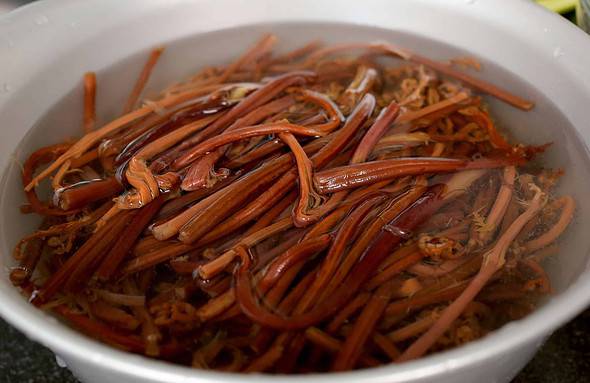
- Taste the gosari: It should be soft. If it’s tough, boil it again in a fresh pot of water for about 20 minutes and then let it sit, covered, until soft.
- Drain. It should make 4 ounces.
Make rice
If you have a usual method for making rice or have a rice cooker, go ahead and make 5 cups of rice like you usually do. But here’s how I do it on a pot on the stove. 2 cups of dried rice makes about 5 cups of cooked rice.
- Rinse 2 cups of rice in cold water and scrub the wet rice with your hand. Rinse and drain until the drained water is pretty clear.
- Put the rice in a heavy-bottomed pot. Add 2 cups of water, cover, and soak for 30 minutes.
- Cook over medium high heat for 7 to 8 minutes until the surface is covered with abundant bubbles that are spluttering noisily and look like they’re about to overflow the pot. Turn the rice over a few times with a spoon and cover the pot again.
- Turn the heat to very low and simmer for another 10 minutes until the rice is fully cooked and fluffy. Remove from the heat.
- Fluff the rice with a spoon to release excess steam. Let the rice stand, covered, at room temperature to keep it warm.
Prepare and cook the ingredients for bibimbap
I like to get a big platter and then put each vegetable on it as they’re ready. I think it looks really pretty, but you don’t have to do this. When all vegetables are prepared and ready to use, the platter looks pretty delicious!
Soybean sprouts:
- Put the soy bean sprouts in a pot and add 4 cups water and 2 or 3 teaspoons salt. Cover and cook for 20 minutes over medium high heat. Take out the sprouts with tongs and put them into a bowl, leaving about ½ cup of sprouts in the pot with the water you used to boil them. This is the soup to serve with bibimbap later.

- In a bowl, mix the sprouts by hand with ½ teaspoons salt, 1 teaspoon minced garlic, and 2 teaspoons toasted sesame oil. Put them on the large platter.
Spinach:
- Cut up the blanched spinach a few times and put it in a bowl. Mix by hand with 1 teaspoon garlic, 1 teaspoon toasted sesame oil, ½ teaspoon kosher salt, and 1 teaspoon sesame seeds. Cover and put it next to the soy bean sprouts on the platter.
Other fresh vegetables:
- Cut the carrot into matchsticks, put them in a bowl, and mix with a pinch of salt. Let stand for 5 to 10 minutes until sweating.

- Cut the red bell pepper into halves, deseed, and slice into strips. Put them in a bowl.
- Cut the zucchini into matchsticks and mix with ½ teaspoon kosher salt.
- Cut the cucumber into halves lengthwise and slice thinly crosswise. Mix with ¼ teaspoon kosher salt.
Beef:
- Cut the beef into matchsticks and put them in a bowl.
- Mix with 1 tablespoon minced garlic, 1 tablespoon soy sauce, 1 tablespoon honey, 2 teaspoons toasted sesame oil, and 1 teaspoon sesame seeds with a spoon.

- Cover and keep in the fridge until ready to use.
Mountain vegetables:
- Cut the fernbrake (gosari) a few times into bite size pieces. Set aside.
- Put the bellflower roots (doraji) in a large bowl. Add 1 or 2 tablespoons salt. Rub for a minute to wilt slightly and release some of the bitterness. Rinse them in cold water a couple of times and drain. If you find some roots are too thick, split them lengthwise. Set aside.
Let’s cook!
- Heat up a pan over medium high heat. Squeeze out excess water from the carrot. Add a few drops of cooking oil to the pan and sauté the carrot for 1 minute. Put it on the platter next to the soy bean sprouts and spinach. Clean the pan with wet paper towel or wash it.
- Heat a few drops of cooking oil in the pan and squeeze out the excess water from the cucumber. Sauté with ½ teaspoon minced garlic and a few drops of toasted sesame oil for 30 seconds. Put it on the platter. Clean the pan.
- Heat up the pan with a few drops of cooking oil. Add the red bell pepper and sprinkle a pinch of salt over top. Sauté for 30 seconds. Put it on the platter. Clean the pan.
- Heat up the pan and squeeze out excess water from the zucchini. Add a few drops of cooking oil and sauté with 1 teaspoon minced garlic, 1 tablespoon chopped green onion, a drop of toasted sesame oil for 1 minute until slightly softened. Put it on the platter. Clean the pan.
- Heat up the pan with a few drops of cooking oil. Add the bellflower roots and sauté for 2 to 3 minutes. Lower the heat to medium so as not to brown them. Add 1 teaspoon minced garlic and a drop of toasted sesame oil. Stir for another minute until a little softened. Put it on the platter. Clean the pan.

- Heat up the pan. Add a few drops of cooking oil. Stir the gosari for 2 minutes until a little softened. Add ½ teaspoon of minced garlic, 2 teaspoons soy sauce, and 2 teaspoons sugar, and keep stirring for another minute. Put it on the platter.
Serve
Here are a couple of ways to serve: bibimbap in a regular, shallow bowl, and dolsot-bibimbap in a stone or earthenware bowl.
In a regular, shallow bowl
- Reheat the soybean sprout soup.

- Divide the cooked rice into 4 portions. Each portion will be a little more than 1 cup of rice.
- Put the rice in each of 4 bowls and arrange the vegetables and beef on the rice. Top with a raw egg yolk and gochujang. If you prefer your eggs and beef cooked, use a fried egg sunny side up and slightly pan-fry the beef before putting them on the top of rice.
- Sprinkle the bibimbap with the sesame seeds and drizzle with sesame oil to taste.
- Ladle the soup to a small bowl and sprinkle some chopped green onion over top.
- Serve right away with more hot pepper paste on the side, and maybe kimchi too.

Dolsot-bibimbap in a hot earthenware bowl (ttukbaegi) or hot stone bowl (dolsot)
- Reheat the soybean sprout soup.
- Put a few drops of toasted sesame oil in the bottom of each of 4 earthenware bowls. They should be big enough to hold 4 to 6 cups each.
- Divide the rice among the bowls. Arrange the vegetables and beef on the rice. Top each serving with a raw egg yolk and 1 tablespoon gochujang. If you prefer your eggs and beef cooked, use a fried egg sunny side up and slightly pan-fry the beef before putting them on the top of rice.
- Set each pot on a burner. Heat over medium high heat until you hear a ticking, crackling sound coming from the rice.

- Sprinkle the bibimbap with the sesame seeds, drizzle with sesame oil to taste.
- Ladle the soup to a small bowl and sprinkle some chopped green onion over top.
- Serve right away with more hot pepper paste on the side and maybe kimchi too.

Eat
Maangchi's Amazon picks for this recipe
It's always best to buy Korean items at your local Korean grocery store, but I know that's not always possible so I chose these products on Amazon that are good quality. See more about how these items were chosen.



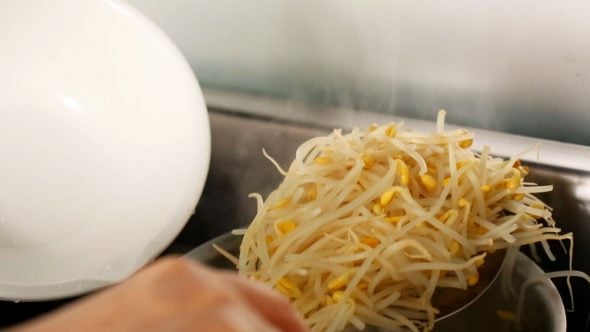
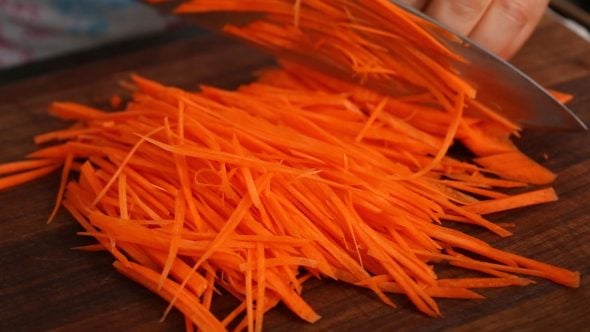
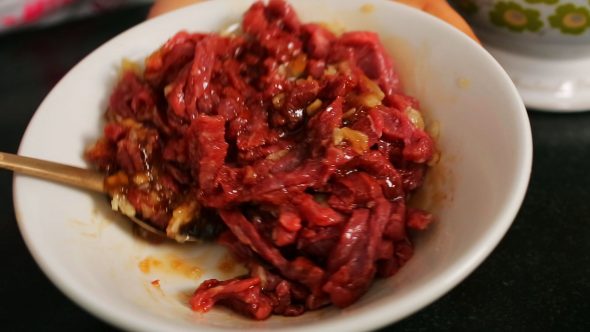
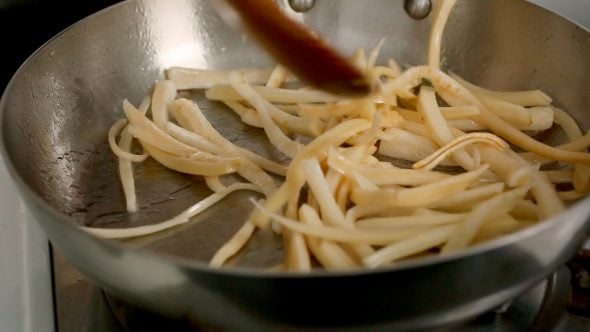
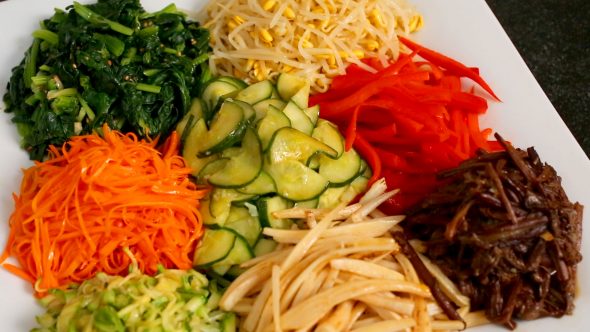
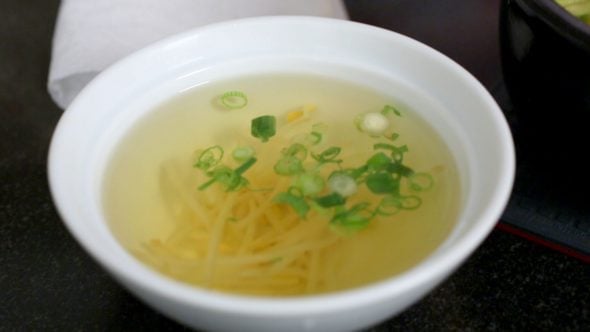
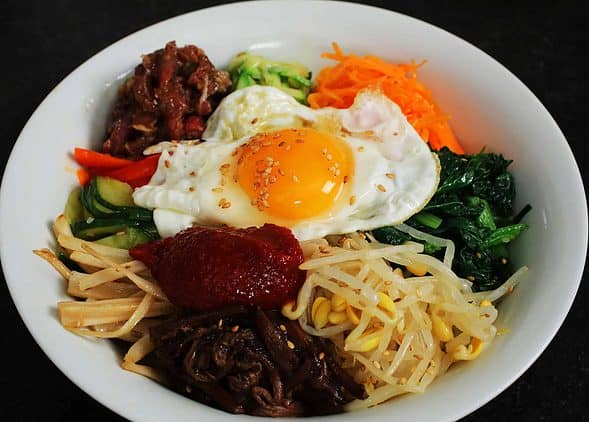

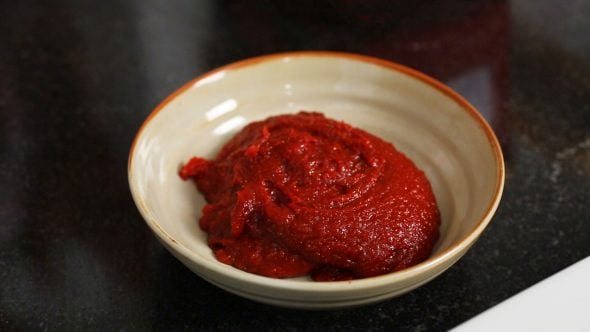
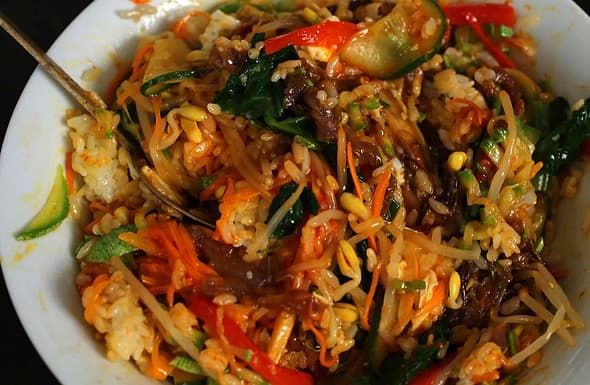






![[OTTOGI] Delicious COOKED RICE...](https://m.media-amazon.com/images/I/41zYdZ3EWJL._SL160_.jpg)




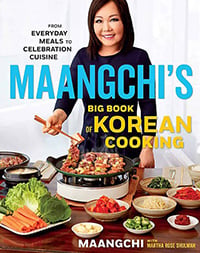





















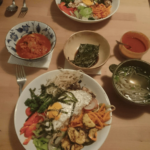
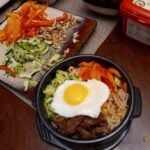
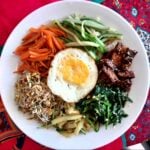
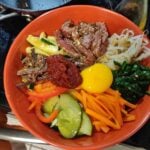
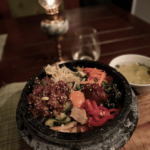
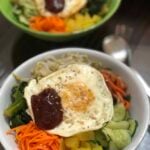
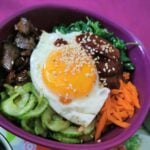
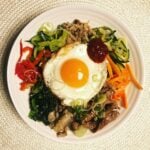
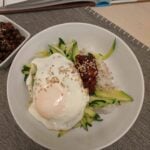
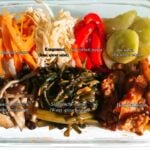
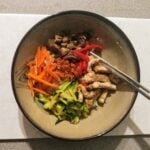
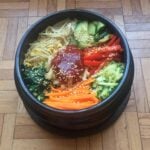

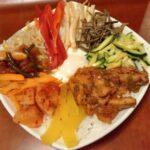

Quick question!! Do you think it will taste okay if I use brown rice instead?
Yes, it will still be delicious!
Made this the other night and it was a huge success (and this was my first experience with Korean cooking)! I didn’t have Kosari, but even without it the dish still turned out well.
Thanks for the easy to follow directions.
Your “huge success” is my success, too! Cheers! yes, without gosari, it will still be delicious!
I can’t figure out how to make my own post, but I wanted to let you know I made this for work and it was a huge success! Everyone loved it
When you say “ts”, do you mean table spoon or teaspoon?
In the US, we use tbsp=table spoon or tsp=teaspoon. Just want to make sure I don’t put too much in! Thanks! :)
Nevermind! I realized as I read down further, it was teaspoon and that you wrote tbs for tablespoon. Haha. Thank you anyway! :) Cannot wait to try this out.
ok, Alice! ts = teaspoon : )
Hi Maangchi –
I bought the already boiled kosari. I left it in the fridge for a week – is it still good to use now? Thanks
Over the past year, bibimbap has become one of my favorite recipes! It was one of the first dishes I made for our “cooking around the world” blog : http://www.196flavors.com/2012/11/04/south-korea-dolsot-bibimbap/
Your dolsotbibimbap looks very beautiful and tasty!
Hai eonni,
I want to make this recipes, but I have a problem with some of the ingredient. But before I ask you, I think I should read the comment above, and I found the answer before I ask you…. Hehehe…. My problem is : hot pepper paste – solved, kosari – solved.
Thank you for the other readers question!
Love you Maangchi eonni!
After a long time I made Bibimbap one more time, but this time I made photo to show you!
Thank you so much for the recipe. I always, wenn I look a new Drama, want to eat something like I see in the movie. Really apprecciate your efford and your strong to do all these dish to show all of us.
Have a very bright day.
Your bibimbap photo is here! https://www.maangchi.com/photo/bibimbap_rice
I am so excited to make this! Ive been craving this…
Thank you for this recipe, it was my inspiration. I made a vegetarian version of your bibimbap last night and used coconut aminos (instead of soy sauce) and coconut sugar (instead of white sugar) and brown rice. Who knew it was so easy? :)
OMG! Can you please give your version of this recipe? <3
Sometimes, my family makes bibimbap, but instead of gochujang paste,they just add leftover dwenjang jigae. Is this normal? Have you heard of this before?
Hey Maangchi, thank you for a very informative blog and recipes! It actually got me interested in cooking cause I’m not a very cook person. Anyways, I have been so interested in Korean culture and keep up the fantastic work. I really appreciate it! Greetings from Australia :)
” I’m not a very cook person” : ) Good luck with your Korean cooking this year 2013!
Dear Maangchi, today I made the best Bibimbap ever!
I’m so tankfull! You’re the best. You made it simple and I like it very why I’ve every day only a little time for myself. After work I’m to tired to do what I want, this way today I take a free day and make Bibimbap for all my family.
Thank you very much, Maangchi.
I wish you a very wonderful day.
wow, I’d like to see what your bibimbap looks like! Cheers!
can you make a new video for this recipe. I try watching it on my tab and phone but its too low on quality hence its really blurry to watch. i would really appreciate it. thank you.
Hi! I also have a question about the stone bowl. Do you heat it on the stovetop? Medium heat or higher? I know you oil the bowl before putting the rice in. How do you keep the oil from burning before you add the rice? Do you add the oil at the last minute before the rice? I like my bowl really hot so it makes the rice crispy:) Thanks!
I usually heat it over medium heat, and I never have a problem with the oil burning before adding the rice.
Hi maangchi I’m really glad to find your website. I really love Korean food.
I always try to find cook book but watching you from You Tube is really awesome.
Now I can cook Korean food and serve it to guest at home. Thanks to you. Good luck!
Thank you very much for your interest in my recipes. Happy cooking!
Ooh Maangchi, I’m so full! I don’t think I’ll ever be able to move again… Your bibimbap was so tasty! It was easy to adapt to my vegetarian diet, and it was so quick to make! Even though I only made enough for one bowl, I could only get through a third before I was done. Healthy and good for staying slim! I think I’ll be making this all the time. :D My favorite part? The shitake mushrooms in sugar and soy sauce! Mmn!
Congratulation!
Your vegetarian version sounds interesting and delicious.
Maangchi,
Kind of weird to say it, but I started watching Korean tv last summer and liked the look of the food so much I wanted to try making it. I’m allergic to wheat, and a lot of food I can regularly get is not something I can eat, so I’ve been leaning very Asian in my choices, and was SO HAPPY to discover your blog. I have always like Asian food, but Korean is my favoritest of the favorites, and so far Bibimbap has been my favorite recipe to try. Pepper paste is amazing stuff!!!! And as far as I’m concerned, Korean food has the perfect amount of spice; enough that you definitely know it’s there, but not so much that you can’t taste what you’re eating.
Thanks so much, and know that I’ll be making a lot of your recipes. The videos really help me, so much!!! You gave me an epiphany with the matchstick chopping of vegetables – I was really doing it the wrong way before I watched your video and it took about three times as long. Thanks a HEAP!
-Elizabeth
It’s great to hear that my video helped you practice your knife skills!
This looks so good! Maybe someone else asked and I just missed it, but do you have to use shiitake mushrooms? They aren’t sold anywhere around here, all I can find in stores is Portabello mushrooms. :(
Where in US are you ?? check out your big grocery store , most grocer now carries shiitake mushroom . But like Maangchi said , you can use white button mushroom too ( this is the most common mushroom sold in US ) , portobello mushroom would be okay too i would think .. she said any kind of vegetables you like too .
I’m in south Texas, about an hour away from Corpus Christi. Boy I feel like an idiot, NOW I see the comment about the white mushrooms. -_- I wonder if it would taste the same to just use white mushrooms to make Japchae? I’ve had the noodles forever, I just can’t find the mushrooms. I’ve even had the produce guys searching all over the store to find some and they had no luck.
Have you checked HEB and Kroger ? I am currently in Houston , not too far from you :D i found both grocery store carry Shiitake mushroom , although they’re quite expensive compared to korean market . I’ve used white mushroom plenty of times before , without shiitake , and it still tastes good . Shiitake is a lot better mushroom than plain old white , but when you don’t have it .. you just have to do with what you have on hand :)
Thank you so much Maanchi! Your videos are fun and very helpful!
I used to live in NYC and loved going to Koreatown to enjoy some great BBQ but I moved out of the city and there was nowhere to get it. I tried your recipe tonight and tried a variation to make it similar to Dolsot Bi Bim Bop by adding the cooked rice to a cast iron pot then adding the vegetables and eggs because I do not have the proper pots and it came out perfect – thanks to you!!!
yay, you did a great job to make dolsot bibimbap! Before adding the cooked rice to the pot, I would drizzle a few drops of sesame oil.
Thank you so much! I will do that next time!
Great recipie, great music
I love Bibimbap and was craving it badly yesterday. Luckily, I found your blog for the recipe. It’s so critical to have that pepper paste for the sauce! Thanks to your blog, I made my first official Bibimbap! It was delicious.
Congratulations on your successful bibimbap making! “It’s so critical to have that pepper paste for the sauce!” and sesame o~il! : )
This looks great and I want to try and make it! Only problem is that I cook only for myself as I live alone and I like making meals for several days. Is any of this good reheated for a few days? If so how do you store it and heat it up?
Yes, you can keep each vegetable in different containers in the fridge for a couple of days until you make bibimbap again.
Bibimbap, is another one of my favorite Korean dish. I first tried it in Korean Air, inside the airplane and it was packed also and i really like this dish. one of my favorite dishes. it is very nutritious and good for your health. Even in Korea in an earthenware pot. The dish is really complete there is beef, vegetables and rice even egg sometimes plus hot pepper paste. combined really heavenly taste.
I have a question, can you skip the kosari if you can’t find any ?
Yes, you can skip kosari. It will still be delicious! Good luck with making delicious bibimbap!
And instead of using pepper paste, can I use the Sriracha sauce instead ? I find it SUPER SPICY for my taste ! hehe .
This is sooo good! Thank you so much for your recipes! I hope you know that everyone here really appreciates the hard work you do, and we love you! Bibimbap is one of my favorite recipes because I can make it for one person. I love that it has everything in one nice, big bowl.
Great news! yummy yummy bibimbap! : )
Hi Maangchi,
Today is my first day to join in your blog. OMG your blog is magnificent and very informative. i cook bibimbop here where i work and we also use kosari (fiddlehead). is there only one kind of kosari? my boss always buy dried kosari and we soak it for days (changing water everyday) before cooking it. sometimes i encounter very hard and thick kosari. any alternative or can you teach me how to identify good quality kosari from thick and hard one while they are in dried form?
Thank you very much and learned many things from your blog.
Welcome to my website! You can learn Korean food and share your thoughts and cooking experience with your fellow Korean food lovers on the forum! https://www.maangchi.com/talk/
I usually buy dried gosari (kosari: fernbrake) from a Korean grocery store. All are good. Check this out. https://www.maangchi.com/ingredients/kosari I posted how to make dried gosari softer.
My dearest maangchi,,
I made my own bibimbab! \(^o^)/ hehe..
Thanks for the recipe.. 잘먹겠슴니다!
yay your bibimbap photo is here! https://www.maangchi.com/photo/widys-bibimbab
beautiful presentation!
Dear maangchi,,
Remember my first bibimbab? I think I put to much garlic on it,,haha.. So today,, I try to make another one,, carefully not to make the same mistake twice..
But since I’m hungry,,rather than cook the vegetables separately,, I just cook them all at once,,hehe.. I call it my emergency bibimbab..
It’s turned out delicious though! Yeayy! I think practices really make perfect.. ;)
haha! Emergency bibimbap sounds great! Actually I often make my bibimbap that way! : )
Thanks for posting this up here! It turned out wonderfully. :)
OMIGAWD!!! I wish I had a big bowl like you Maangchi-nunna! Question how do you make your red chili paste. mine never comes out quite like yours?
I buy my hot pepper paste, but someday I will post the recipe on my website. https://www.maangchi.com/ingredients/hot-pepper-paste-gochujang
hi, i’m new here but i’ve tried your kimchi recipe yesterday and it turn out well,, my housemates love it. this is the first time i make kimchi from the scratch,thanks so much for the recipe, anyway i have question for bibimbap recipe, do you use salty soy sauce or sweet soy sauce???
I’m happy to hear that your first time kimchi making turned out good. I use dark soy sauce called jinganjang. https://www.maangchi.com/ingredients/soy-sauce
Hi Maangchi, i was wondering why the salt you use has a tan color to it. Is it that vegetable seasoning or something? I forgot what it’s called, but it comes in a green package. It’s basically MSG, but mad from vegetable or something. My mom uses it to cook all the time!! Or is it just plain salt that you’re using… lol xD
yes, it’s plain salt. : )
Hi Maangchi,
You are just amazinggg i love ur recipes thank you for sharing them with us. I have a quick question you have added sugar when you stir-fired the vegetables (mushroom, Kosari etc.,) I am not much of a sweet person so can i add some red pepper paste? or can i just skip it?
Thanks,
Sush.
Allo Sush!
Just skip sugar. : )
Hi Maangchi
I love bibimbap and want to try to make this today or tomorrow. I have the stone bowl but can you show me how to make bibimbap in it? After I prepare all the ingredients, do I put all the ingredients in there and then cook it on the stove, if so how long?
My mom and I are big fans of yours!
Thanks,
Linh
Linh,
Place some sesame oil on the bottom of the bowl and add warm rice and vegetables on top. Heat it up and wait about a few minutes until rice on the bottom starts burning. You will hear cracking sound. “tak..tak..tak” ^^
Thanks Maangchi. I am going to try it today. I had a hard time finding kosari so I am using just regular royal ferns I found at a Korean store.
Linh
Anyounghaseyo Maangchi! I just want to thank you for your great recipes. I lived in Korea for 7 years but now I live in Japan and I am always missing my favorite dishes. But thanks to your website, which I refer to quite often, I can still enjoy the delicious tastes of Korea!
잘 먹었습니다!
Great! Welcome to my website!
Hello Maangchi, I loved your post about bibimbap,
Would you pls allow me to use your recipe for our company (ABB) ‘s inhouse magazine ?
It’s not commercial one at all, if you want you can have it for your reference.
yes, I will be honored to have my recipe in your magazine!